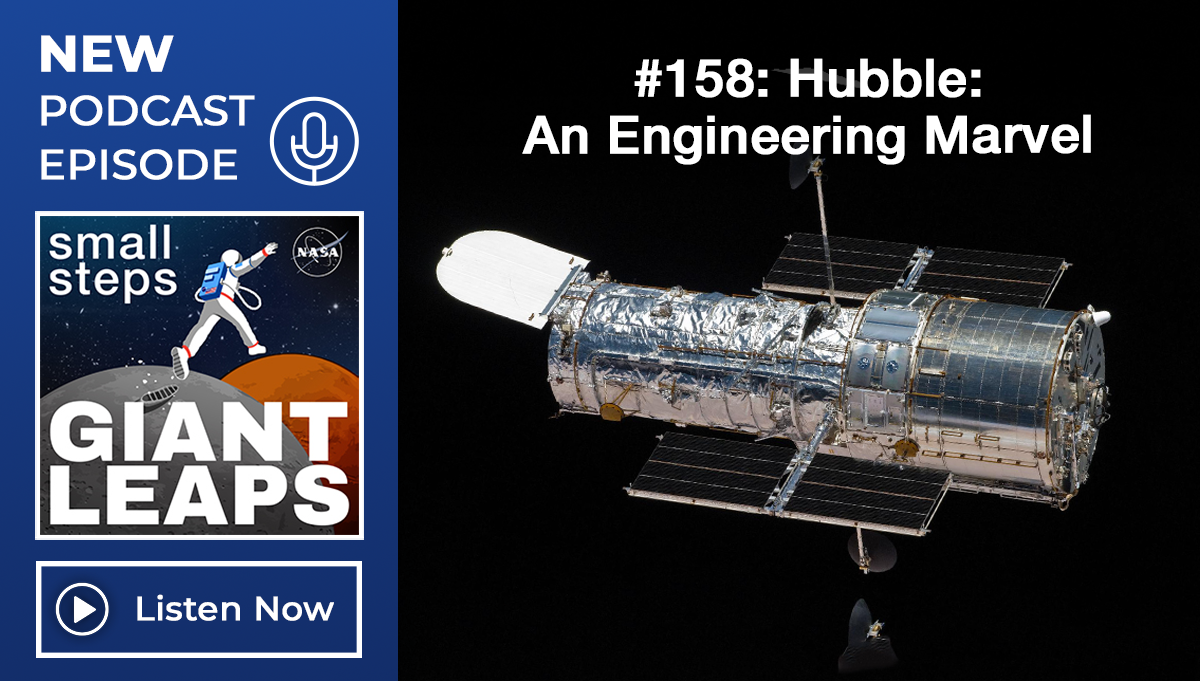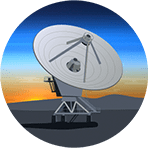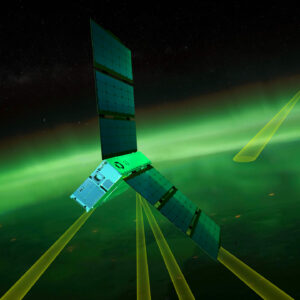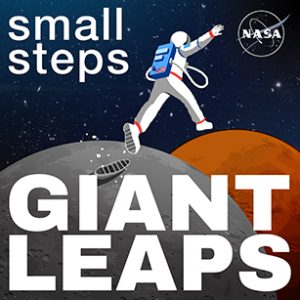What can the auroras tell us about our planet’s relationship with the Sun? NASA’s EZIE mission looks into it.
Every second, up to 2 million metric tons of charged particles stream from the Sun at 1 million miles per hour. It’s called the solar wind. When eruptions from the surface of the Sun point toward Earth, these particles flow into our upper atmosphere and create electrical currents over the poles, triggering spectacular auroras. But that beauty belies the threat these electrical currents can pose to our assets in space and infrastructure on the ground. Now, there’s a new mission to study these electrojets and its name is EZIE, or the Electrojet Zeeman Imaging Explorer. Program Executive Dr. Jared Leisner tells us all about it.
In this episode, you’ll learn about:
- How the Sun-Earth relationship affects life on Earth
- How EZIE will measure electrical currents in Earth’s magnetosphere
- How community organizations can be part of the mission

Credit: NASA
Dr. Jared Leisner is the EZIE program executive in the Heliophysics Division at NASA Headquarters. He began his career as a researcher on planetary magnetic fields, studying Saturn and the interactions with its icy moons as part of NASA’s Cassini mission. His first position in NASA’s Science Mission Directorate was managing competed research programs in the Planetary Science Division. After transitioning to Heliophysics, his responsibilities included leading the pre-formulation activities for the Geospace Dynamics Constellation strategic mission, managing the fleet of operating missions, and guiding the strategic decadal survey effort. He holds a PhD in geophysics and space physics from the University of California, Los Angeles.
Resources
Internships
NASA’s EZIE Mission Page
Johns Hopkins APL’s Mission Page
Participate in Collecting Mission Data
Courses
APPEL Virtual PM Challenge (On Demand)
Communicating Technical Issues (APPEL-vCTI)
Foundations of Aerospace at NASA (APPEL-vFOU)
Transcript
Andres Almeida (Host): Welcome to Small Steps, Giant Leaps, your NASA APPEL Knowledge Services podcast where we dive into the lessons learned and real-life experiences of NASA’s technical workforce. I’m your host, Andres Almeida.
Every second, up to 2 million metric tons of charged particles stream from the Sun at 1 million miles per hour. It’s what’s called the solar wind. When eruptions from the surface of the Sun point toward Earth, these particles flow into our upper atmosphere and create electrical currents over the poles, triggering spectacular auroras. But that beauty can also pose a threat to our assets in space and vital infrastructure on the ground. Now, there’s a new mission to study these electrojets and its name is EZIE, or the Electrojet Zeeman Imaging Explorer.
Launched in March of 2025, EZIE is comprised of three small satellites, each the size of a carry-on suitcase. The trio fly above Earth’s surface, collecting data that may help researchers develop more accurate and powerful models to predict space weather events that can affect society.
We’re here with Dr. Jared Leisner, program executive for EZIE.
Hey, Jared, thanks for being here with us.
Jared Leisner: Thank you for having me.
Host: Can you talk a bit about the EZIE mission, and what makes it unique compared to past space weather missions?
Leisner: EZIE is a science mission that’s going to study Earth’s auroral electrojets. It’s going to determine their structure and their variability, especially during times when we see space weather events happening. Now I use a little bit of jargon, so I want to explain briefly.
Heliophysicists, those of us that study the interconnections between the Sun, Earth’s local space environment and Earth’s upper atmosphere, use the concept of geospace, which is the broad system of both Earth’s magnetosphere and Earth’s upper atmosphere.
To connect the magnetosphere, which is Earth’s magnetic field, expanding out into space to the upper atmosphere, you need something, something that can carry information and power. That happens through electrical currents. The auroral electrojet is one of these key currents that make this connection.
So, in a way, the auroral electrojet is one of the things that creates the concept of geospace and space weather events, the things that affect our satellites in space, our infrastructure on the ground, and all of the communication that happens in between them occurs within that connected system. So, the electrojets are a key piece of this puzzle.
There have been some previous studies of the electrojets, both from space and from the ground, but they’ve been very limited. The electrojets occur at about 100 kilometers altitude, or about 65 miles, which is very challenging to get to with any sort of local measurement. So, we’ve measured it from a distance, and those data just aren’t good enough to understand the necessary structure and variability that we, that we need to understand. And that’s where EZIE comes in.
EZIE is three CubeSats all carrying a single instrument called the Microwave Electrojet Magnetogram, or MEM. And MEM is the first instrument that allows us to remotely observe the electrojet. These three satellites are going to orbit around the Earth and then measure the electrojet remotely and map out its structure during normal times and during active times.
From that the EZIE project science team is going to study it and understand and characterize the variability in the structure, especially during these times of high space weather activity, and resolve some key questions and hypotheses about how it behaves in these times that we really need to be paying attention to.
Host: What are the advantages of having these three small CubeSats versus a large satellite that we typically think of?
Leisner: So, the first advantage I would talk about is cost effectiveness. They’re smaller, they’re more compact. You can, you can execute them with a smaller team, and you can launch them with these rideshare capabilities that we’re seeing emerge in commercial space.
The other is that the bigger the spacecraft you have, the more work it takes to control it and guide it. EZIE does not have propulsion, but we need the spacecraft to be able to move within their orbits, especially relative to one another.
EZIE is going to be doing that by rotating the spacecraft and increasing the drag so it’s going through the upper atmosphere. There are atmospheric particles there. They impact the spacecraft. They slow the spacecraft down. So, without propulsion, you would be able to very accurately control the position of the spacecraft relative to one another. If you were to try to do that with a bigger spacecraft, it would take longer, it would be harder to rotate. So having these small suitcase-size CubeSats really enables this mission operation paradigm.
Host: So, what kind of data are you hoping to collect? What will it look like?
Leisner: As I mentioned, EZIE is carrying only one instrument, the MEM. And what MEM is going to measure is a specific emission coming from oxygen molecules at that 100-kilometer altitude. Now, as you heard in the name of EZIE there’s a physical effect called Zeeman splitting. And Zeeman splitting is a physical phenomenon where, in the presence of a strong magnetic field, an emission that occurs at one wavelength actually splits into two wavelengths, and the amount of that split tells you what the magnetic field is doing. And then there are some other secondary effects that the team is able to leverage as well.
By looking at that split and these other effects, the team is actually able to remotely detect, remotely determine the magnetic field’s strength and orientation. And if you remember your high school physics, in the presence of an electrical current, the magnetic field is modified. So, we’re going to be measuring the frequency of an emission, which will give us the strength and orientation of the magnetic field, which allows us to determine the electric current, and that is the electrojet.
Host: EZIE doesn’t have to fly through active aurorae…
Leisner: So, that’s correct, EZIE is at a high inclination, so it’s orbiting near the poles, and it will not be changing its orbit. But with the MEM instrument, it’s able to look down and remotely sense and remotely observe the electrojets as the Earth rotates underneath it.
Host: Can you talk about any technical challenges during development of EZIE?
Leisner: Every project has technical challenges. For EZIE, they were taking an instrument that had heritage from previous instruments and trying to miniaturize it down to fit into a CubeSat. They were working with a commercial spacecraft provider, so there was the integration of both the teams and the hardware. However, I think one thing that might be useful to think about for EZIE is linking the development to the actual operations that comes after launch. As I mentioned earlier, EZIE will be controlling its, its orbit through these differential drag maneuvers, where they turn the spacecraft and from drag from the atmosphere, they can slow down one of the spacecraft.
Now, this depends strongly on what the atmosphere is doing at the time, and Earth’s upper atmosphere is strongly related to what the, to what the Sun is doing, what we call the solar cycle. Now, we have predictions for the solar cycle.
From when EZIE was selected to when it was approaching launch, when it was going through its final design review, the Sun started waking up. And the Sun was going stronger and having more of an effect on Earth’s upper atmosphere than was anticipated, and things were evolving so much on the Sun’s surface that our official models to forecast were not able to keep up.
Host: Wow.
Leisner: So, EZIE was in this position where it relied upon accurate knowledge of what the Sun will be doing and how will be affecting the upper atmosphere in order to plan what orbit its going into, when it should launch, what kind of length of operations it’s going to be able to guarantee. And that was all a little bit up in the air. So, the team went off. They had to do additional studies. They had to work with the professional forecasters to figure out what would be the best way to keep the mission safe and operating while completing the science that they promised NASA.
So, they actually ended up pulling in additional models and talking to additional experts and modifying their launch and their operations to account for this uncertainty and to ensure that they were able to complete the mission that they were planning.
Host: That’s interesting. And I imagine when you say the Sun was waking up, you mean, was the Sun in solar maximum.
Leisner: Right? The Sun was moving from solar minimum up to solar maximum around this time, where EZIE was going through its final review and doing the final preparations for launch.
Host: Oh, so what sort of benefits you know? Why is EZIE important for everyday people? What sort of benefits to space weather forecasting can this provide?
Leisner: So, I think there are two different questions there, and I’d like to, I’d like to split them off.
The first is to the forecasting. As I mentioned earlier, these overall electrojets are part of the central connections to geospace, the space weather events that we see that affect our ground and space-based assets, they are all related to what’s going on in the electrojets. To understand the geospace, you need to understand these, these currents – but we don’t understand these currents. And if we don’t understand these currents, how can we predict them accurately? EZIE is the first mission that can actually fill in those key knowledge gaps and inform our forecasting activities.
The other aspect about why does this matter? What kind of impact does this have on people’s day-to-day lives? So, we have ground infrastructure, we have metal tubes, we have metal wires. And in one of the space weather phenomenon that we worry about are induced currents, GICs. This is where a changing magnetic field in space can drive a current in the ground infrastructure. And those currents actually degrade the pipes, the wires that we use [in] day-to-day life.
The auroral electrojet, as I mentioned earlier, it is an electrical current that is changing through time. So, by understanding the electrojets, we’re able to better understand and predict the effect that they will have on ground infrastructure that we build in the United States and that our friends and allies in other countries build in their countries.
Host: The final two questions for you here. So, Jared, how can the public get involved with the EZIE mission? Is there a way to do that?
Leisner: Absolutely. I love this. The EZIE team has set up a program where the public is able to go onto their website and request magnetometers. They call them EZIE Mags. These are magnetometers that individuals and organizations can deploy out in the field, and they will measure the magnetic field and send those data back to the EZIE team for analysis.
Now, you’ve heard me say how the electrojet and what EZIE is measuring is all about magnet fields, all about changing magnetic fields. We see that in space, but as you heard me say earlier, we also see that on the ground. The EZIE Mag project is a way for individuals to contribute data that would be directly used by the science researchers.
We’re looking to send them out to schools, interested groups, enthusiastic individuals, and we’ve made it very easy. The EZIE-Mag website, EZIEmag.JHUAPL.edu, has a link. Get your free EZIE-Mag. You fill out a short form, the team will send you an EZIE-Mag that you can deploy. The team has also assembled tutorial videos that show how you request set up and connect these units, and then when they get sent out, everyone that connects these units knows that they will be contributing to the scientific research coming out of the mission.
Host: That’s awesome, and we will link this website on our podcast episode at appel.nasa.gov.
Leisner: I appreciate that.
Host: Of course.
Jared, my final question for you is: What do you consider to be your giant leap?
Leisner: NASA is an interesting place. There is a culture, especially within the Science Mission Directorate where I work, of people taking on responsibilities that are quote, unquote, above their pay grade. And I took advantage of that.
Many people probably don’t know, but NASA’s science vision is built upon a document called the Decadal Survey. These are mandated by Congress, and they’re written by the National Academy of Sciences. They’re commissioned by the head of NASA science and generally managed directly by the head of each science division, Heliophysics Division for me. That is all to say that they’re very important to NASA science, and they’re very important to get it right.
One giant leap that I took was I went to my boss, the head of the Heliophysics Division, and I pitched that I should take the decadal survey on everything, all of the preparation, all of the crafting of the science vision, and then seeing it through to the eventual implementation. And she said, “Yes.”
So that was about five and a half years ago. I have had the opportunity, because of that one request, to play a part in developing the National Science Vision for Heliophysics. I’ve gotten a lot of experiences that I would not have had otherwise, and it’s also opened me up to working at a different level, within the organization and within the national and international space science domain. I feel like it’s also shown me what I am capable of doing and coming out of this, I am really looking forward to what’s next.
Host: Yeah, and we’re happy you’re part of it. Jared, thank you for your time today. Really appreciate it.
Leisner: Thank you for having me. It’s been quite enjoyable.
Host: That’s it for this episode of Small Steps, Giant Leaps. For more on Jared and the topic we discussed today, visit our resource page at appel.nasa.gov. That’s A-P-P-E-L dot NASA dot gov. Don’t forget we also have other podcasts like Houston, We Have a Podcast, Universo Curioso de la NASA, and Curious Universe, which just kicked off an exciting five-part miniseries, all about our favorite planet: Earth. As always, thanks for listening.
Outro: Three. Two. One. This is an official NASA podcast.







